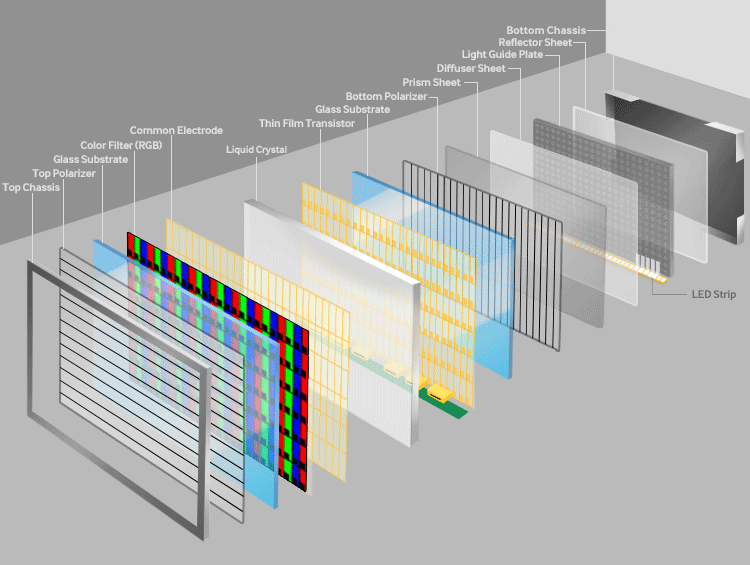AOD is a feature of LED, OLED, or SuperAMOLED display smartphones. This feature allows us to show text, date, time, or graphics on our screen even when the display is turned off.
Always-On Display (AOD) is only available on the LED, OLED, or SuperAMOLED screen, not on the LCD screen. The reason lies behind the technology of these displays.
Let’s learn about the basics of our smartphone display.
There are primarily two types of display for a smartphone, LCD and LED. There are various types of LED displays, such as OLED, AMOLED, MicroLED, QLED, etc. There are also different types of LCDs, such as TN, IPS, etc.
To fully understand the Always-on Display, lets first see how these two display technology — LCD and LED — works.

How LCD works?
The above picture shows a room which has two windows. Sun’s bright light is coming in. The owner has installed a room darkening curtain on each of those windows. If we drag the curtain over a window, the light will not come into the room through that window. Therefore, though the sun’s light is not in our control, we can control the curtain to let the light in through whichever window we want.
The above picture is the representation of a 2 pixel LCD. The sun is called a backlight, each window is called a pixel, the curtain is called liquid crystal, and our mechanical work to open and close those curtains is called voltage or power.
Here is an image of the actual LCD.

The backlight on the LCD is always on. The electronics only controls the passage of lights on a pixel level through the control of liquid crystal in the Display. Therefore, even if we show a black image on the LCD, the backlight is not turned off. It’s on, but the liquid crystals are hindering the light in the pixel. It is why LCD can’t create a true black.
Now, let’s look into the LED Display.
How LED Display works?
LED stands for Light Emitting Diode. Modern electronics has enabled us to make these LEDs so small that even our naked eye can’t see these individuals LED. One key benefit of this Display is that we can individually turn on or off these light-emitting diodes.
Therefore, Does Always-On Display drain the battery? The answer is no. The Always-On Display does not drain battery because, in an LED, OLED, or Super AMOLED display, the display driver only turns on those pixels (LED) required to show text, image, or graphics related to AOD, while all other pixels (LED) turned off. Hence, It uses very little energy, and in our experiment, on our Samsung phones, we found that it only uses 1% battery energy per hour.
Should I turn on Always-On Display?
On our Samsung phone, we use the AOD feature. However, many are concerned to turn on this AOD for two reasons:
- Battery drainage concern.
- OLED display screen burn concern.
Let’s address these issues.
From our experience, Always-On Display uses about 1% battery charge per hour with only time, date, and battery percentage shown on the AOD screen. We also have interviewed many of our friends, colleagues, and family members. Those who use this AOD, they did not notice any battery drainage issue. Moreover, even if AOD is on, the screen goes off when we put our phone into our pocket or purse. Therefore, from our real-life experience, we can testify that Alaway-on Display does not drain the battery.
Here is the second concern.
Does AOD cause a screen burn?
The OLED display has a drawback. Its called the “screen burn” issue. If an image, text, or graphics stays too long at the same place, that graphics will leave a ghost mark into the Display. For example, the black notification bar on some Samsung phones or the direction icon in the Google maps if you use the maps too often. So, the concern with Always-On Display is that it will cause a “screen burn” on the OLED Display. Don’t worry; it won’t
We have been using AOD on our Samsung phones for the last three years, and it did not cause any screen burn.
The Always-on Display does not cause screen burn; it’s because of the Always-on text, graphics, time, date, notifications, etc. do not stay at the same location all the time. The software that powers AOD shifts them on a routine basis to not cause this issue.
Why Always-On Display not Available on the LCD screen?
Technically it is possible to provide this feature on an LCD screen smartphone. But it will drain the battery. It’s because the LCD screens backlight is always on, which will discharge the phone’s battery. Unlike OLED, we can’t control individual pixel lighting on an LCD. Therefore, the Always-on Display feature on an LCD screen smartphone does not make any practical sense.
Conclusion:
In short, Always-On Display is a great feature that many people don’t know about, and many don’t use it, thinking it will drain their battery power. However, the AOD feature takes very little energy to operate; therefore, we can use it on our phone without concern.
Sources:
